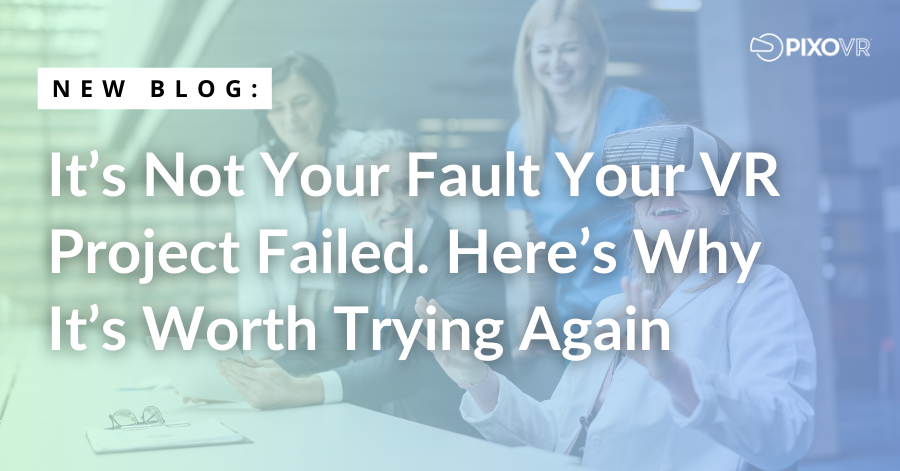For more information and to take a deeper dive into VR and how it could work for your organization, check out our FREE whitepapers, here!
We get it, adding virtual reality (VR) to training is a huge leap. Traditional training programs are focused on what needs to be learned and the best way to get that info to employees, whether that be in person in a classroom or via elearning. VR involves a lot of new unfamiliar technology as well as being a major cultural shift.
But, it’s supposed to be the next big thing, so training managers tried it—then promptly went back to the old methods because yes, it indeed was hard. Unfortunately, VR training isn’t going away, it’s growing in popularity at a CAGR of 14.4%. And that means that this is one leap that eventually needs to be taken.
This article covers the reasons why it is important for training managers to try again with VR and what can be done differently to get it right.
Common reasons VR initiatives fail
If your initial project to incorporate VR into your training program failed, you aren’t alone. Training managers report being frustrated by a lack of internal support in setting up the technology, problems with getting the headsets to work outside the company firewall, and a lack of support from HR and communications to educate employees on the value of VR. And you probably didn’t have any incentive to put in the extra effort to make it a success.
The difficulty of VR often can be avoided with the proper knowledge, technology, and support. For instance, some headsets are made for gaming, while others are better for corporate training needs. There is software that helps training managers with VR to get content to the headsets and track use and results. But even the most tech-savvy training manager can’t do this alone. They need the help of IT to get the appropriate technology and configure and test the system to work in their environment.
If VR was launched correctly at your company, it would have been a combined effort among HR, Training, IT, Communications, and Innovation leadership. Everyone would need to do their part to educate employees on the value of VR and the long term vision for using it to make improvements. If VR is treated like an experiment instead of an investment in the future, then it will be slow for the company to advance.
4 Big reasons why it’s worth the effort to try again
So if it isn’t easy, why bother trying again?
There are a few reasons to consider to answer this question:
- It works – Studies have shown that VR is extremely effective for both hard and soft skill training where practice and feedback is important. When used in combination with classroom or elearning materials, it is a powerful tool to ensure the training sinks in.
- It’s transforming training – The outcomes possible with VR to significantly reduce costs and improve worker outputs changes the way that executives think about training. Training will become a more strategic part of the company versus a cost center. And that means that the reach and impact of training will expand with more budget and resources to make a difference.
- It’s a career maker (or breaker) – By learning how to incorporate VR into your training program, you’ll be in high demand. That means the possibility for higher pay and the ability to work anywhere you want. Of course on the flip side of this, those training managers that don’t begin to adopt VR may make themselves obsolete.
- It’s here to stay – Whether you are a fan of VR or not, it isn’t going away. It is already working at many companies and making a big difference. VR training is being used to onboard faster, to reduce training costs, to close the skilled labor gap, to reduce rework from costly mistakes, and to improve worker safety. And with the development of platforms like the Metaverse, more VR corporate VR use cases will continue to arise.
Virtual reality isn’t something that can be ignored, but the good news is that figuring it out presents a great opportunity for training managers to advance their career in a big way.
Important steps to VR success
- Get buy-in from HR, IT, and Innovation leadership to get the appropriate support needed.
- Work with a VR content provider that can support your goals with content and the technology to make it all work together.
- Collaborate with this team to put a long term VR plan into place from pilot through to expanding over time to new users and use cases.
- Have IT help purchase, configure, and thoroughly test your VR training system.
- Roll out the new pilot with help from HR and Communications to get employees excited.
- Continue to meet with the team quarterly to review metrics and progress.
- Buy a cape, because now you’re a superhero in helping your company realize the benefits of VR.
The technology, content, and experience in VR has advanced significantly in the past few years. It’s ready for training managers to take the next step toward strategically improving corporate training.
Need help getting VR right? PIXO VR can help. Click here to arrange a meeting with a VR expert.


Leave a Reply
You must be logged in to post a comment.